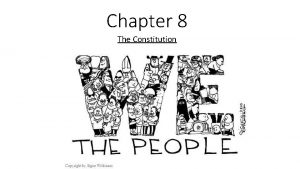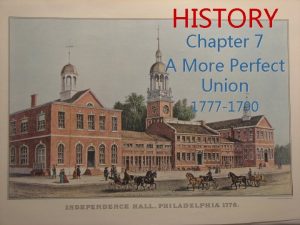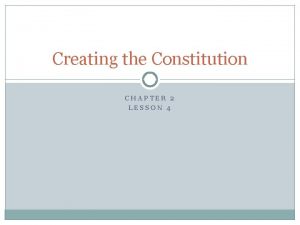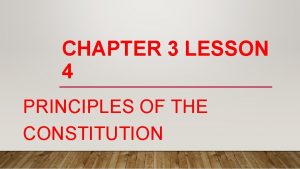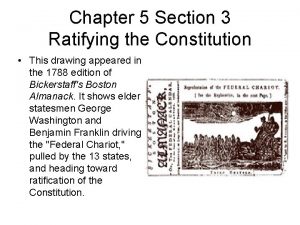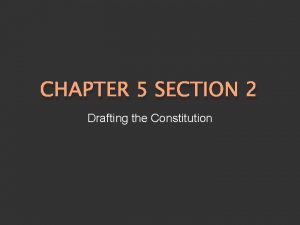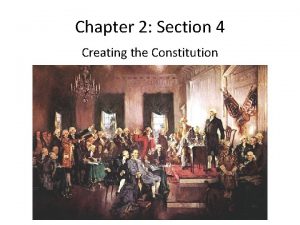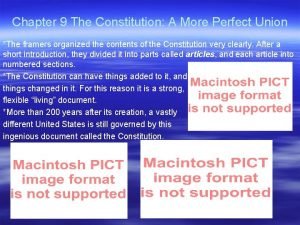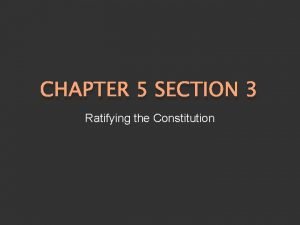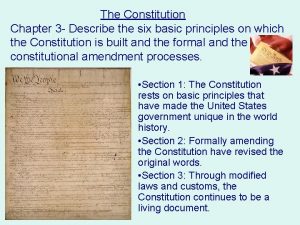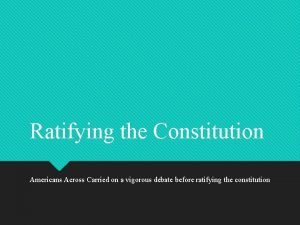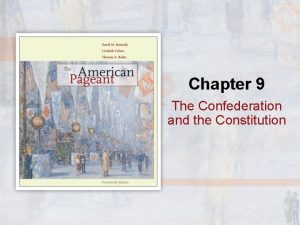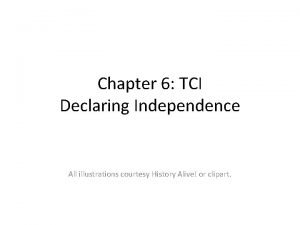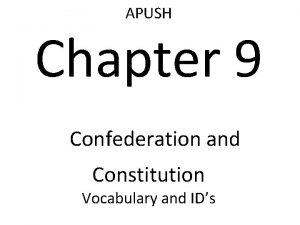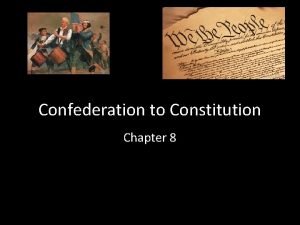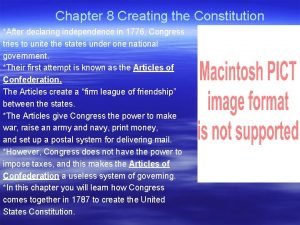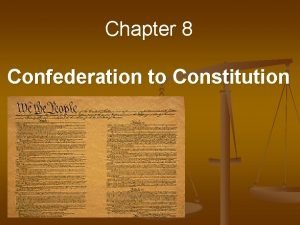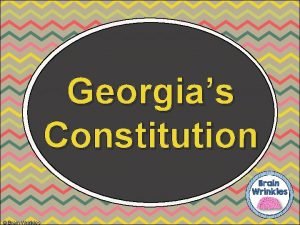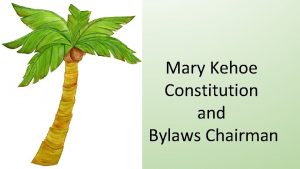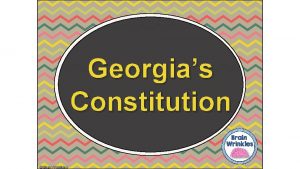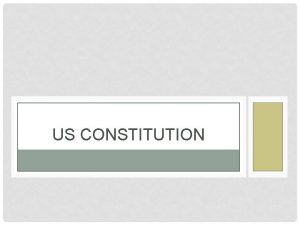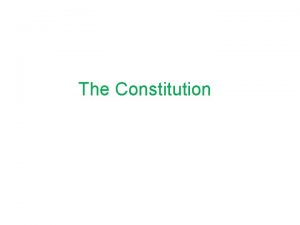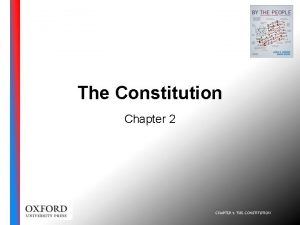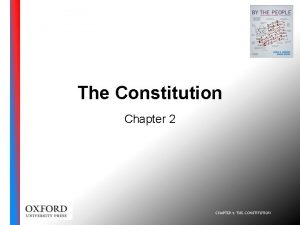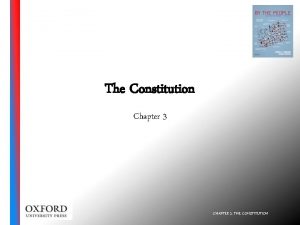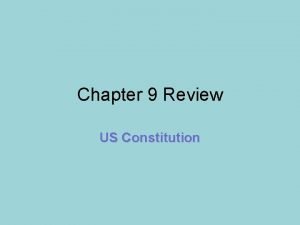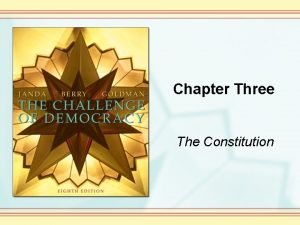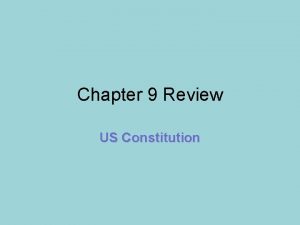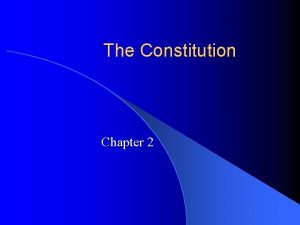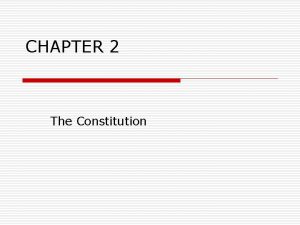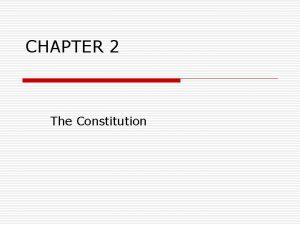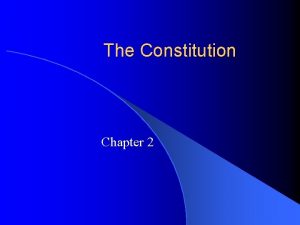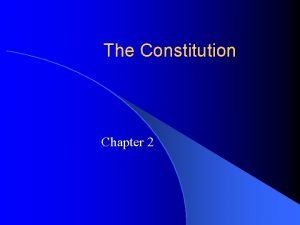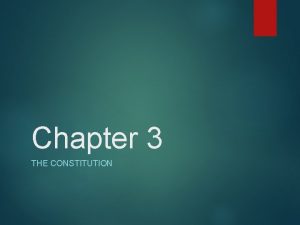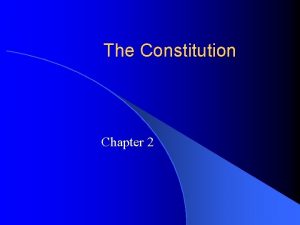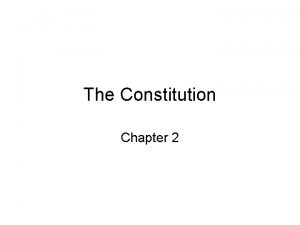Chapter 3 The Constitution 1 Lesson 1 The




























































- Slides: 60

Chapter 3: The Constitution 1

Lesson 1: The Country’s First Governments Objectives: Ø Compare influences of ancient Greece, the Roman Republic, the Judeo-Christian tradition, the Magna Carta, federalism, the Mayflower Compact, the English Bill of Rights, the House of Burgesses, and the Petition of Rights on the government of the United States. Ø Explain essential characteristics of the political system of the United States, including the organization and function of political parties and the process of selecting political leaders. 2

Lesson 1: The Country’s First Governments Essential Question: Ø Why do people create, structure, and change governments? 3

Lesson 1: The Country’s First Governments Vocabulary: 1. constitution 2. bicameral 3. confederation 4. Articles of Confederation 5. ratify 6. ordinance 7. Ordinance of 1785 8. Northwest Ordinance 9. shay’s Rebellion 10. area 11. impact 4

Lesson 1: The Country’s First Governments • State Constitutions: – New Hampshire was the first colony to organize as a state and write a constitution, detailed written plan for government. – State Governments • • Legislature to make laws Most were bicameral, two parts or houses. Members were chosen by different methods Elected a governor (by legislature or citizens) – Carry out the laws • Courts – What laws meant – How to apply laws to each new situation 5

• Bill of Rights – Based on ideals from Declaration of Independence – Right to life, liberty, and pursuit of happiness – Guaranteed basic freedoms and legal protections • Trial by jury • Protection of personal property 6

Lesson 1: The Country’s First Governments • The Articles of Confederation – Confederation—a group of individual state govt. that unite for a common purpose – Article of Confederation—document became the first constitution of the U. S. of America. – Set up a “league of friendship” – 13 state ratified, approved, the Articles – Created a one house legislature with each state having one vote. – Controlled the army – Dealt with foreign countries. 7

Lesson 1: The Country’s First Governments • Link game: Articles of Confederation True or False Game • http: //glencoe. com/sites/common_assets/net works/social_studies/civics/e. Games/true_fals e/c 03_l 01_tf/True. False. html 8

Lesson 1: The Country’s First Governments • Link Video: Shays’s Rebellion • C: UserseapplinDownloadsShays. Rebellion. mp 4 9

Lesson 1: The Country’s First Governments – Northwest Ordinances • Confederation Congress passed two ordinances—laws – Ordinance of 1785—a law that set up a plan for surveying western lands » How land would be sold » Divided land it to townships, six mile square, 36 sections one mile square – Northwest territory—law that set up a govt for the Northwest Territory and a plan for admitting new states to the Union » “There shall be neither slavery nor involuntary servitude in said territory. ” 10

Lesson 1: The Country’s First Governments – Weaknesses of the Articles • Congress could not pass a law unless 9 states voted for it. • Amend, or change, the articles required all 13 states to agree, • Power was strictly limited. States controlled power. • Did not allow for a governor—no one to see that laws were enforced, obeyed • No power to tax. 11

Lesson 1: The Country’s First Governments • As you read pps. 76 -77, fill in the table about Shay’s Rebellion. Question Word Who? Question Who led the rebellion? Answer Daniel Shay What? When? Why? How? 12

Lesson 1: The Country’s First Governments • Shays’s Rebellion – Fight for independence left county in debt. – State began to tax citizens heavily. – Trade slowed and jobs lost. – Farmers could not sell crops and went into debt. – Daniel Shays led 1200 farmers in an attack on a federal arsenal. • Felt state had no right to punish him for a problem he did not create. • Rebellion was quickly stopped but was a warning to the country—need for a stronger national government. 13

Lesson 1: The Country’s First Governments • Exit Slip: • What would our country be like if we were still under the Articles of Confederation? 14

15

Lesson 2: Creating a New Constitution Objectives: Ø Compare influences of ancient Greece, the Roman Republic, the Judeo-Christian tradition, the Magna Carta, federalism, the Mayflower Compact, the English Bill of Rights, the House of Burgesses, and the Petition of Rights on the government of the United States. Ø Explain essential characteristics of the political system of the United States, including the organization and function of political parties and the process of selecting political leaders. 16

Lesson 2: Creating a New Constitution Essential Question: Ø Why do people create, structure, and change governments? 17

Lesson 2: Creating a New Constitution Vocabulary: 1. Constitutional Convention 2. Great Compromise 3. Three-Fifths Compromise 4. Electoral College 5. Federalist 6. federalism 7. The Federalist Papers 8. Anti-Federalist 9. process 10. despite 18

Lesson 2: Creating a New Constitution • Link Video: Freedom Train Starts U. S. Tour • C: UserseapplinDownloadsFreedom. Train. St arts. USTour. mp 4 19

Lesson 2: Creating a New Constitution The Constitutional Convention--meeting of state delegates in 1787 leading to adoption of a New Constitution • The Delegates: – Common features of most delegates • Well educated • Had political experience • Thirty to forty years old 20

Lesson 2: Creating a New Constitution • The First Decisions: – Original purpose was to revise Articles but soon realized an entirely new plan of govt. was needed. Meeting became known as the Constitutional Convention – George Washington chosen to guide the convention. – Each state had only one vote, – Simple majority (7 votes) decided any issue. – Kept discussions a secret so that delegates would feel free to speak openly and frankly with out fear of what the public might think. • Doors guarded • Windows kept shut despite, regardless of, summer heat 21

Lesson 2: Creating a New Constitution As you read pps. 80 -81 compare and contrast the Virginia Plan and the New Jersey Plan by completing a Venn Diagram. Virginia Plan Two house congress Great Compromise Plan for a national govt. New Jersey Plan One house congress Bicameral legislature Representation based on state population Representation based on equal for all states state population-House Equal representation Favored by large Favored by small for all state-Senate states 22

Lesson 2: Creating a New Constitution • The Great Compromise—an agreement between two or more sides. Liberty's Kids: "We the People" | Discovery Education 23

Lesson 2: Creating a New Constitution Compromising for a Constitution • The Virginia Plan – President – Courts – Congress with 2 houses – State population would decide how many representatives were in each house. – Supported by states with large populations 24

Lesson 2: Creating a New Constitution • The New Jersey Plan – Based on Articles of Confederation – One house congress – Each state would have one vote – Congress could set taxes and regulate, or control, trade. – Committee to carry out laws – Backed by smaller states 25

Lesson 2: Creating a New Constitution • The Three-Fifths Compromise: included part of slave population in calculating house representation. 26

Lesson 2: Creating a New Constitution • Other Compromises – Trade • • Northern state felt congress should regulate trade Southern feared Congress would tax exports South worried that Congress might stop trade of enslaved people Compromise Congress could regulate trade but could not tax exports, nor ban slave trade before 1808. – National Government • Election of a president—Congress vs People • Compromise--Electoral College, a group of people named by each state legislature to select the president and vice-president. 27

Lesson 2: Creating a New Constitution Federalists and Anti-Federalists: • Who were the Federalists? – Backed new constitution – Federalism—form of govt. in which power is divided between the federal (national) govt. and states. – Federal law supreme – Leaders—A. Hamilton, James Madison, John Jay Wrote essays—The Federalist Papers 28

Lesson 2: Creating a New Constitution • Who were the Anti-Federalists? – Opposed the constitution – Destroy the liberties won by Am. Revolution – Strong national govt. Would ignore rights of states – Favor the wealthy – Did not have a Bill of Rights 29

Lesson 2: Creating a New Constitution • Launching a New Nation: – Federalist vowed to add a Bill of Rights – 9 states voted to ratify the Constitution – Constitution took effect in June 1788. – By May 1790 all 13 states had ratified the constitution 30

Lesson 2: Creating a New Constitution Exit Slip: Complete one of the following- • Compare and contrast the position of the Federalists and the Anti-Federalists. • How well do you think the system developed by the Founding Fathers still works today? What are some examples of ways in which it is or is not working. 31

32

Lesson 3: The Structure of the Constitution Objective: Ø Explain essential characteristics of the political system of the United States, including the organization and function of political parties and the process of selecting political leaders. Essential Question: Ø Why do people create, structure, and change governments? 33

Lesson 3: The Structure of the Constitution Vocabulary: 1. Preamble 2. article 3. amendment 4. legislative branch 5. executive branch 6. judicial branch 7. assume 34

Lesson 3: The Structure of the Constitution As you read pp. 86 -88, complete a table about the three parts of the U. S. Constitution. Organization of the U. S. Constitution Major Part 1. Preamble 2. Articles 3. Amendments Purpose Introduction Describes branches of govt. and how Constitution can be changed List of changes to the Constitution 35

Lesson 3: The Structure of the Constitution • Link Video: Separation of Powers in the New Government • C: UserseapplinDownloadsSeparationof. Po wersinthe. New. Government. mp 4 36

Lesson 3: The Structure of the Constitution The Parts of the Constitution: • The Preamble—states goals and purposes of the govt. • Power of government comes from the people. • Fundamental purpose to ensure domestic Tranquility 37

Lesson 3: The Structure of the Constitution • The Seven Articles—Main parts of the constitution – First three articles states the powers and responsibilities of each branch of govt. • Article 1: Legislative branch—law making, declare war, Congress • Article 2: Executive branch—law enforcing, commander in chief, headed by President • Article 3: Judicial branch—interprets laws, courts – Article IV explains the relationship between the states and national govt. – Article V—how Constitution can be changed – Article VI—Declares Constitution the “Supreme Law of the Land” – Article VII—describe how Constitution was to be ratified. 38

Lesson 3: The Structure of the Constitution Complete the chart with the solution in the constitution for each weakness in the Articles of Confederation. Weakness in the Articles of Confederation Solution in the Constitution Congress had no power to collect taxes. Congress had no power to regulate trade. Congress had no power to enforce its laws. No single leader or group directed government policy. No national court system existed. Approval by 9 of 13 states was needed to pass laws. Approval of all 13 states was needed for amendment. 39

Lesson 3: The Structure of the Constitution • The Amendments—additions and changes to the Constitution – 27 Amendments • First 10 make up the Bill of Rights 40

Lesson 3: The Structure of the Constitution Amending and Interpreting the Constitution • Framer made amendment process difficult • Formal and informal Amendments • Two step process; – proposal • Act of Congress: 2/3 rds vote in both houses of Congress • National convention called by 2/3 rds of state legislatures – Ratification • ¾ of states must ratify—either be voted on by state legislature or by special state convention. • Informal-actions by a president that have led to unofficial changes. 41

Lesson 3: The Structure of the Constitution • Link image: Presidents Engaging Troops Without Congressional Declaration of War 42

Lesson 3: The Structure of the Constitution • Interpreting the Constitution – Necessary and Proper clause- implied powers. (Powers of Congress that are not specifically listed in the Constitution) – Final authority for interpreting the Constitution is the Supreme Court. 43

44

Lesson 4: Principles of the Constitution Objective: Ø Explain the concepts of separation of powers and checks and balances among the three branches of state and national governments. Essential Questions: Ø How do societies balance individual and community rights? Ø How does social change influence government? 45

Lesson 4: Principles of the Constitution Vocabulary: 1. popular sovereignty 2. limited government 3. rule of law 4. separation of powers 5. checks and balances 6. enumerated powers 7. reserved powers 8. concurrent powers 9. supremacy clause 10. ensure 11. assign 46

Lesson 4: Principles of the Constitution • Link Video: Constitutional Convention • C: UserseapplinDownloadsConstitutional. Co nvention. mp 4 47

Lesson 4: Principles of the Constitution • As you read pp. 92 -95, complete the graphic organizer to identify principles of the Constitution. Principles of the Constitution 48

Lesson 4: Principles of the Constitution Major Principles of Government • Popular Sovereignty—the idea that the powers of govt. lies with the people. – Example: Voters can reject and replace representatives who serve them poorly. 49

Lesson 4: Principles of the Constitution • Limited Government and the Rule of Law – Limited government—govt can only do what the people want it to do. – Rule of law—the law applies to everyone, even those who govern. – Both prevent tyranny by the govt. and protect the liberty of the people. 50

Lesson 4: Principles of the Constitution • Separation of Powers – Division of federal govt. into three branches – Each branch with a different task. • Executive-Headed by President – (Commander in Chief) • Legislative-Congress – (Declare war) • Judicial-Courts – Influenced by Baron de Montesquieu – Limiting any one branch from getting too much power. 51

Lesson 4: Principles of the Constitution • Checks and Balances—System in which each branch of govt. is able to check, the powers of the others Refuse to approve treaties 52

Lesson 4: Principles of the Constitution As you read pp. 96 -97, Complete the Venn diagram. Sort the list into the correct part of the Venn Diagram. • Protect public welfare and safety • Carry out all expressed powers • Establish local governments • Provide for general welfare • Regulate trade within a state • Maintain army and navy • Conduct elections • • Establish courts Borrow money Declare war Collect taxes Enforce laws Coin money Regulate trade between states and with foreign nations. 53

Federal and State Powers National Govt. National & State Govt. 54

Lesson 4: Principles of the Constitution Federalism • Three Types of Power – Enumerated powers—powers directly granted to the National govt. by the Constitution. (expressed powers) – Example Coin money • Reserved powers—powers set aside for the States. (regulating trade within state borders, setting up schools, and making rules for marriage and divorce. ) • Concurrent powers—powers shared by the state and federal govt. (collecting taxes, borrowing money, and setting up courts and prisons. 55

Lesson 4: Principles of the Constitution • The Supremacy Clause—the constitution and other laws and treaties made by the national govt, are “the Supreme Law of the Land” (more powerful than state law) • The Constitution Today—US Constitutions stands a powerful symbol of American values. – Source of pride and unity to the nation’s citizens 56

Lesson 4: Principles of the Constitution Exit Slip: Choose one of the following to complete. 1. How did the Framers of the Constitution attempt to protect Americans from the abuse of power by the government? 2. What are some examples of enumerated, reserved, and concurrent powers held by your parents or guardians (national government) and yourself (state governments)? 57

58

Chapter 3 Review 1. Can you think of a situation in which the supremacy clause might take effect? 2. Review your notes on enumerated, reserved and concurrent powers. Identify examples of enumerated, reserved, and concurrent powers held by your parent/guardians (National government) and yourself (state government). 59

60
 The constitution lesson 1 principles of the constitution
The constitution lesson 1 principles of the constitution Texas constitution vs us constitution
Texas constitution vs us constitution Nc constitution vs us constitution
Nc constitution vs us constitution Constitution what is constitution
Constitution what is constitution Chapter 8 lesson 1 principles of the constitution
Chapter 8 lesson 1 principles of the constitution Chapter 7 lesson 2 forging a new constitution
Chapter 7 lesson 2 forging a new constitution Chapter 2 lesson 4 creating the constitution
Chapter 2 lesson 4 creating the constitution Lesson 4 principles of the constitution
Lesson 4 principles of the constitution Becoming a millionaire chapter 3 lesson 2
Becoming a millionaire chapter 3 lesson 2 Chapter 5 section 3 ratifying the constitution answer key
Chapter 5 section 3 ratifying the constitution answer key Chapter 5 section 2 drafting the constitution
Chapter 5 section 2 drafting the constitution Chapter 2 section 4 creating the constitution
Chapter 2 section 4 creating the constitution Chapter 9 the constitution a more perfect union
Chapter 9 the constitution a more perfect union Chapter 5 section 3 ratifying the constitution
Chapter 5 section 3 ratifying the constitution Chapter 3 section 1 constitution scavenger hunt answers
Chapter 3 section 1 constitution scavenger hunt answers Chapter 5 section 3 ratifying the constitution answer key
Chapter 5 section 3 ratifying the constitution answer key Chapter 9 the confederation and the constitution
Chapter 9 the confederation and the constitution Tci chapter 6 answers
Tci chapter 6 answers Chapter 9 confederation and constitution
Chapter 9 confederation and constitution Chapter 8 confederation to constitution
Chapter 8 confederation to constitution Chapter 8 creating the constitution
Chapter 8 creating the constitution Chapter 8 confederation to constitution
Chapter 8 confederation to constitution Chapter 1 lesson 1 your total health answer key
Chapter 1 lesson 1 your total health answer key Hình ảnh bộ gõ cơ thể búng tay
Hình ảnh bộ gõ cơ thể búng tay Lp html
Lp html Bổ thể
Bổ thể Tỉ lệ cơ thể trẻ em
Tỉ lệ cơ thể trẻ em Chó sói
Chó sói Tư thế worm breton là gì
Tư thế worm breton là gì Hát lên người ơi
Hát lên người ơi Môn thể thao bắt đầu bằng chữ f
Môn thể thao bắt đầu bằng chữ f Thế nào là hệ số cao nhất
Thế nào là hệ số cao nhất Các châu lục và đại dương trên thế giới
Các châu lục và đại dương trên thế giới Công thức tính thế năng
Công thức tính thế năng Trời xanh đây là của chúng ta thể thơ
Trời xanh đây là của chúng ta thể thơ Cách giải mật thư tọa độ
Cách giải mật thư tọa độ 101012 bằng
101012 bằng độ dài liên kết
độ dài liên kết Các châu lục và đại dương trên thế giới
Các châu lục và đại dương trên thế giới Thể thơ truyền thống
Thể thơ truyền thống Quá trình desamine hóa có thể tạo ra
Quá trình desamine hóa có thể tạo ra Một số thể thơ truyền thống
Một số thể thơ truyền thống Cái miệng nó xinh thế
Cái miệng nó xinh thế Vẽ hình chiếu vuông góc của vật thể sau
Vẽ hình chiếu vuông góc của vật thể sau Nguyên nhân của sự mỏi cơ sinh 8
Nguyên nhân của sự mỏi cơ sinh 8 đặc điểm cơ thể của người tối cổ
đặc điểm cơ thể của người tối cổ V. c c
V. c c Vẽ hình chiếu đứng bằng cạnh của vật thể
Vẽ hình chiếu đứng bằng cạnh của vật thể Vẽ hình chiếu vuông góc của vật thể sau
Vẽ hình chiếu vuông góc của vật thể sau Thẻ vin
Thẻ vin đại từ thay thế
đại từ thay thế điện thế nghỉ
điện thế nghỉ Tư thế ngồi viết
Tư thế ngồi viết Diễn thế sinh thái là
Diễn thế sinh thái là Dot
Dot So nguyen to
So nguyen to Tư thế ngồi viết
Tư thế ngồi viết Lời thề hippocrates
Lời thề hippocrates Thiếu nhi thế giới liên hoan
Thiếu nhi thế giới liên hoan ưu thế lai là gì
ưu thế lai là gì Sự nuôi và dạy con của hươu
Sự nuôi và dạy con của hươu




